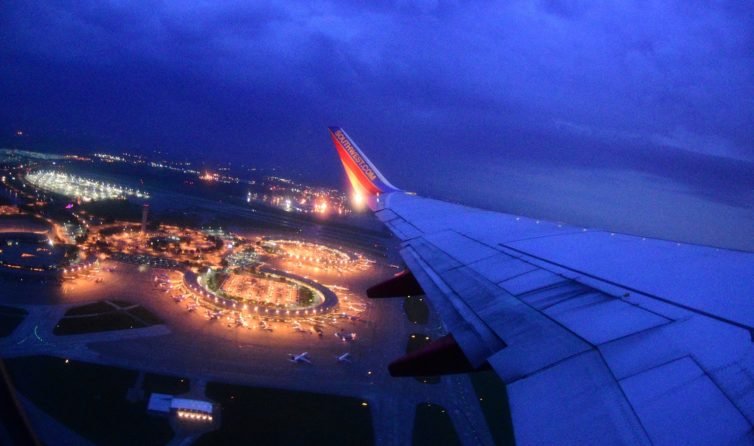
An early morning departure from Kansas City International – Photo: JL Johnson
It has been three-hundred and ninety days since I last flew. That flight was as routine as possible: Southwest Airlines from Chicago Midway back to Kansas City, concluding a standard trip to visit with business partners. At the time, there was some concern over risks of a pandemic but the topic wasn’t a worry for most. Headlines of the day were about the Iowa caucuses, Trump’s first impeachment hearing, and a Pegasus 737 sliding off the runway in Istanbul. 2020 was going to be an incredible year for travel, both for the work -and- personal varieties. We all know how that turned out. Like many, I decided that flying during a global pandemic was not a good idea. Shortly after, my employer instituted an outright ban on travel. Events across the board were canceled and Delta parked a sizable chunk of their fleet on one of Kansas City’s runways.
My reasons to not travel were varied. Back in November, David cared for most of them. If you haven’t read his piece, I would recommend starting there because this is a sort of follow-up. Go ahead and click, we’ve got it set up to open in a new tab for your convenience. One crucial piece that I think David left out was that I don’t believe either of us were particularly concerned about *our* health, but the risk of contracting and unknowingly spreading to others. That is an important part of the narrative which I think has been missing from the conversation. I am not worried about me. I am worried about my wife, my son, my son’s teacher, his schoolmates, their families… Public health is less about the individual, and more about the population. My decision to not fly was not about me, it was a selfless one.
But now I’m ready to fly! What has changed? Click read more and let’s get into it.
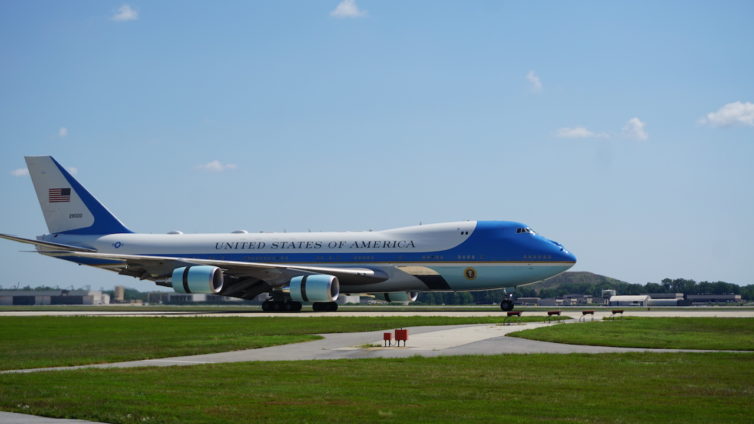
Air Force One lands at Joint Base Andrews – Photo: National Geographic/Renegade Pictures
Recently, I had the opportunity to have a sneak peek at the upcoming National Geographic documentary on the new Boeing 747-8i planes that are being heavily converted to take on the role of Air Force One. While the current planes, based upon the 747-200, are maintained impeccably, they’re getting long in the tooth at over 30 years old.
This behind-the-scenes look was pure AvGeek gold, but also appeals to all audiences. My nine-year-old daughter thought it was great (and told me to say so in this review)!
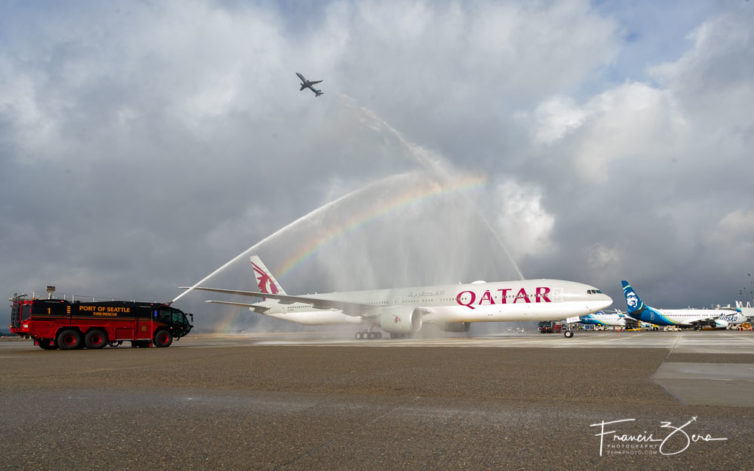
A Qatar 777-300ER receives a water-cannon salute as it taxis to its gate at Sea-Tac Airport
Qatar Airways (QR) launched service from Hamad International Airport in Doha, Qatar, to Seattle, Washington, on Jan. 29, 2021, two months ahead of schedule. It also marked the first new service to Seattle-Tacoma International Airport since the COVID-19 pandemic began.
Inaugural flights are always a joy to cover – you get to see other media colleagues and friends, there’s always a bit of a festival atmosphere, and, best of all, you get to go out onto the ramp at a busy international airport to take photos and enjoy the experience of being airside.
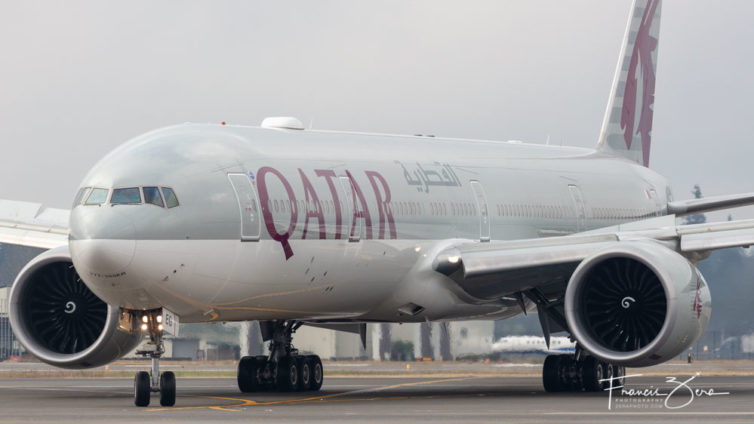
The 777 is an imposingly large aircraft
Qatar now serves the three largest cities on the U.S. West Coast: Los Angeles, San Francisco, and Seattle. The Seattle service will be served by Boeing 777s with 42 seats in Qsuite business class and 312 seats in economy. The Qsuite seat layout is a 1-2-1 configuration, and economy is 3-4-3. Seattle service begins at four times weekly (Mondays, Tuesdays, Wednesdays, and Fridays), and is scheduled to switch to daily service on July 1.
-

-
A Qsuite was set up for the occasion – they are quite spacious
-
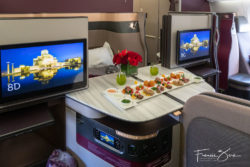
-
The food service was impeccable
-

-
Details included custom amenity kits
The new Seattle service will offer connections from the U.S. to global destinations in Africa, India, Nepal, and Pakistan, among others. The national carrier of the State of Qatar continues to rebuild its network, which currently stands at over 120 destinations with plans to increase to more than 130 by the end of March.
Before the inaugural event, I had the opportunity to chat on the phone with Mark Drusch, SVP of Revenue Management, Alliances and Strategy at Qatar Airways, who’s based in Doha.
“We understand that there are Somalis in Seattle who want to go home we know where our customers need to fly. We have flown a robust schedule even in the depths of covid, so we’ve had our finger on the pulse of the market and have been able to accurately gauge the movements that are required,” he said, citing strong pent-up demand for travel to East Africa, Southeast Asia, and the Indian subcontinent.
Further, covid has opened up a wave of interest in travel to exotic/under-visited destinations. “We have got a massive developing market between the U.S. and more exotic beach destinations like the Seychelles,” Drusch said. ‘People want to go someplace a little more isolated, and that market has developed quite nicely.”
He also cited the attractiveness for the airline of the strong business environment in Seattle and the Pacific Northwest. “This area has not had a problem during the pandemic,” he said, adding that “the Pacific Northwest will rebound faster because of the kinds of businesses we have up here.”
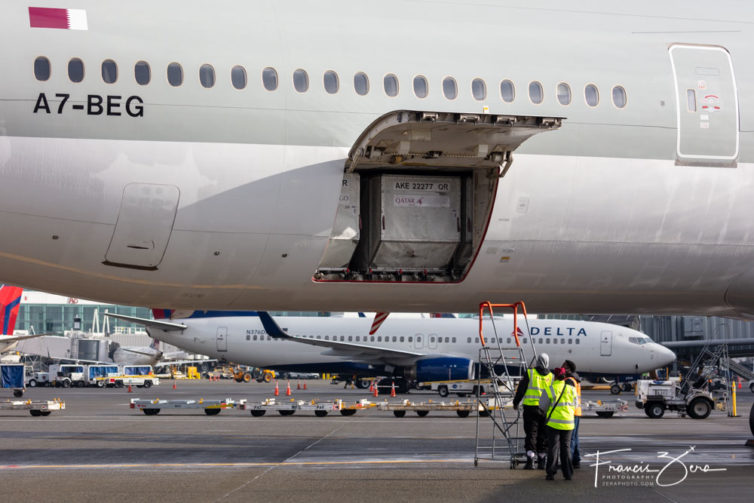
The 77W’s cargo hold was filled with containers. Qatar flies the large jets, in part, to maximize its cargo-handling opportunities.
Cargo is the one aviation sector that has seen growth since the emergence of COVID-19. “Our cargo market has just boomed during the pandemic. We are the largest passenger/freighter operation in the world, we were experts already in carrying cargo on freighters and passenger planes, and we’re flying the 773, which has lots of cargo capacity.”
Asked if Qatar sees itself as being in competition with Emirates for connecting passenger traffic, Drush said, “Lets be honest – the airline industry is very competitive, but we’ve been different than Emirates – they’ve pulled back from the U.S. and Europe. We’ve continued to be in the market for our customers; in the middle of covid we repatriated almost 2 million people.”
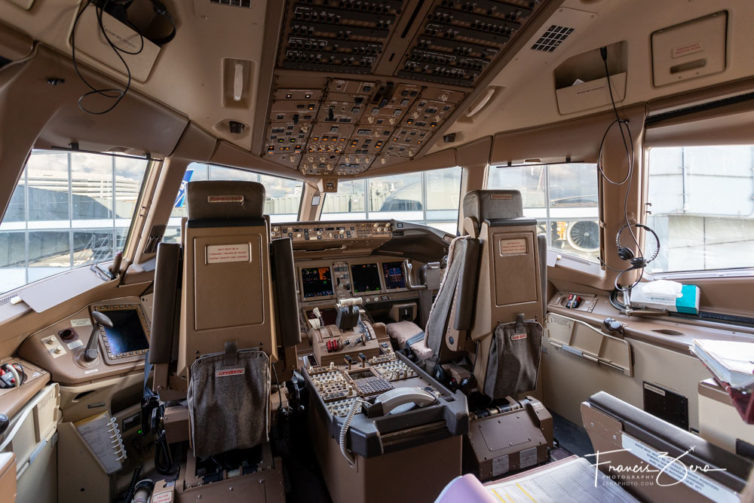
The 777-300 cockpit is also quite spacious
Qatar Airways Privilege Club and Alaska Mileage Plan members can now earn frequent flyer miles on both carriers. Beginning March 31, 2021, members can also redeem frequent flyer miles on both carriers’ full networks and elite oneworld Ruby, Sapphire, and Emerald status perks, including lounge access.
-
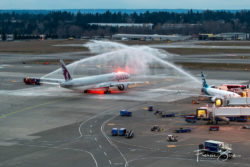
-
The departing flight also got a water-cannon salute
-
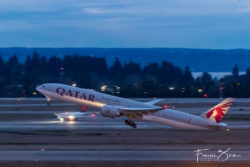
-
Headed back out on the nearly 14-hour flight from SEA-DOH
Of interest to those in the Pacific Northwest who are Alaska Airlines frequent fliers, Qatar is part of the oneworld alliance, which Alaska recently joined. Alaska Airlines will connect customers from the U.S. West Coast to Doha and beyond via its other hubs in Los Angeles and San Francisco, complementing existing strategic partnerships with JetBlue and oneworld carrier American Airlines.
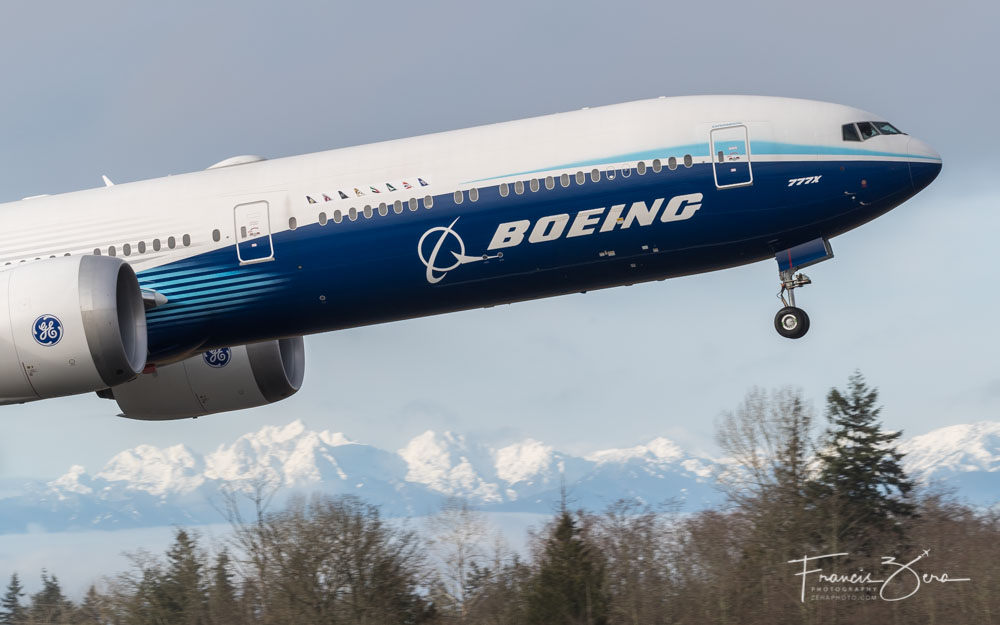
Happy new year, AvGeeks! As you might know, at the end of every year we take a walk down memory lane, reviewing our favorite stories from the previous 365 days of aviation adventures. We ended last year’s story by saying “I think this is the part where I say things like, 2020 is going to be bigger and better than ever!!!”
Well … oof.
Still, we had stories to tell, and you all were awesome about sticking with the site. We hope that reading about flying helped distract you a tiny bit from the tough times of 2020. Let’s have some fun reviewing some themes and storylines from the year. Plus, we share the top ten most popular stories on the site over the past year. You won’t want to miss it!
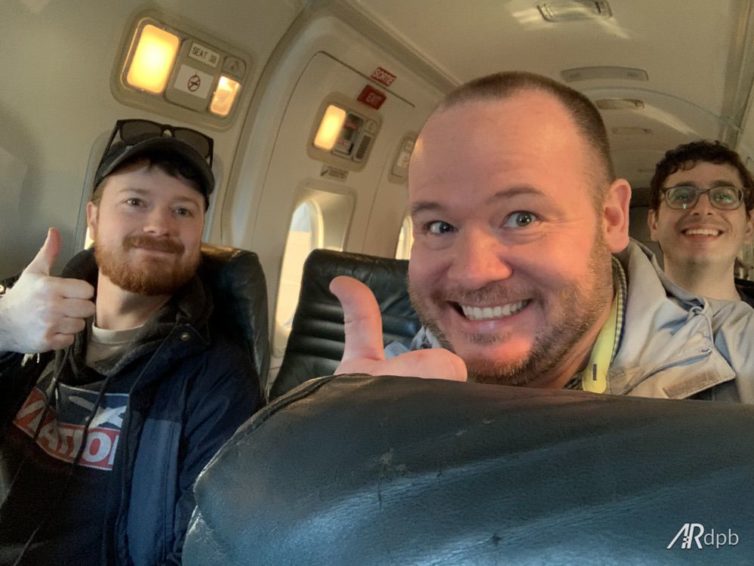
Unfortunately we’re only a few days into 2021 and we already have our first major airline crash. Keeping it brief, here’s the basics of what we know:
The airline: Sriwijaya Air is an Indonesian low-cost carrier that has operated since the early 2000s, with domestic and a few short international routes. The airline has had a few runway overrun accidents, but nothing like this before. However the Indonesian low-cost carrier segment as a whole, which has been growing like wildfire to accommodate demand in its developing home country, has been fraught with safety issues.

A 737-500 operated by Sriwijaya Air subsidiary NAM Air – from the airline website
The airplane: The aircraft involved was a 26-year-old Boeing 737-500 with the registration PK-CLC. It was first operated by Continental Airlines, and came to Sriwijaya later in its life. Of course, this is not a 737 MAX. It’s from a generation of the 737 lineage with a longstanding great safety record overall. So far, most of the mainstream media coverage we’ve seen has made that distinction clear, which we’re glad to see (for the sake of keeping unnecessary hysteria to a minimum).
The flight, SJ182: The flight had 62 people on board. All that we know about the five-minute flight for now is from flight tracker data, and it looks like the plane lost over 10,000 feet of altitude in less than a minute, four minutes into the flight. A trajectory like that suggests something significantly worse than an engine loss or minor malfunction. Other losses of aircraft with pre-crash trajectories like that have been affected by things like bombs, unrecovered stalls, or a truly catastrophic level of damage to the airframe. As for what happened in this case, it’s far too early to speculate. There was definitely some bad weather in the area, though we don’t have granular enough data to know exactly what was going on around the plane at the point it began its dive.
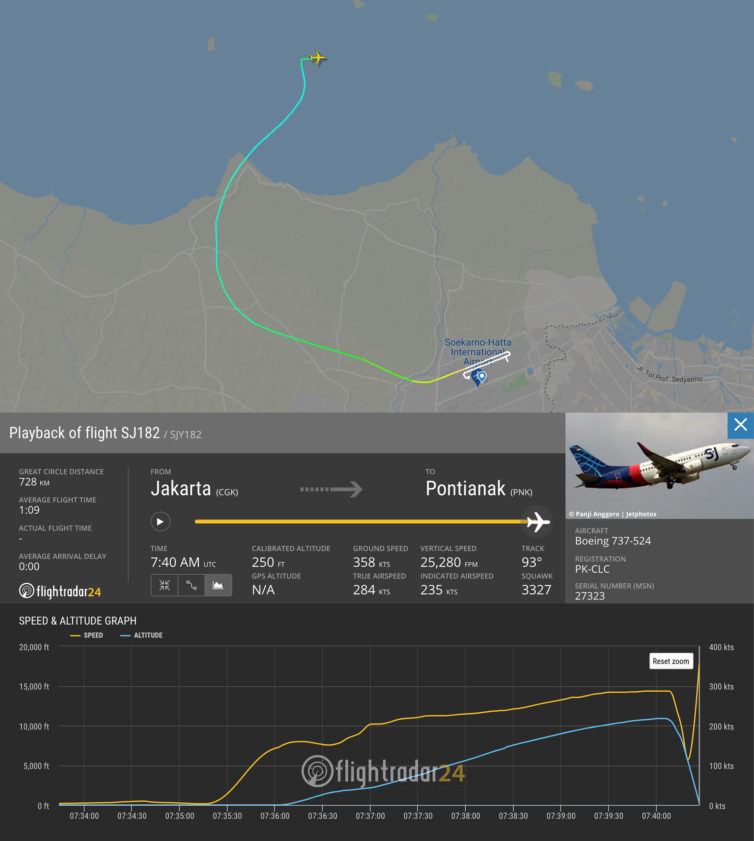
Courtesy of FlightRadar24 – flightradar24.com
Wreckage has been spotted in the water, and it does not appear likely that there are any survivors. Our thoughts go out to the passengers and crew lost, and their families. We’ll be keeping an eye on the news, though airline incident investigations are thorough and often take some time to yield definitive findings.














